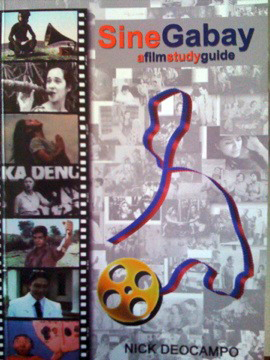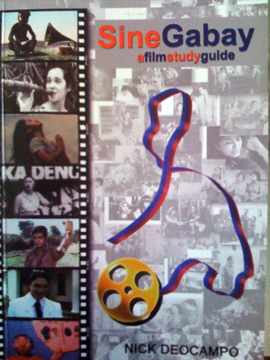FILIPINOS are generally known to have an aversion to reading, and educators often despair at how difficult it is to make students appreciate the printed word. Given a choice between books and films, most Filipinos would opt for the moving image rather than text.
Filmmaker and teacher Nick de Ocampo offers a solution: Why not make students learn from the best Filipino movies?
That is exactly what he hopes will result from his new book, SineGabay: A Film Study Guide. A listing of 100 of the best Filipino movies, the book helps teachers and students “read” films, decode the messages they contain, and learn lessons to supplement what they learn —or fail to—from books.
SineGabay literally offers the gamut of Pinoy movies from A to Z. It starts with the very apt 2001 film “Abakada Ina” starring Lorna Tolentino as the illiterate mother who becomes obsessed with educating herself after realizing how the lack of education has caused her and her family a multitude of problems. The book ends with “Zamboanga,” a film made in 1937 starring Fernando Poe Sr. and Rosa del Rosario, and discusses the travails of a young Muslim couple in love and overcoming the odds.
The book catalogs each film and provides basic information: the year of production, producers, length, cast, synopsis. It then offers areas of study to which the film can be useful. In “Abakada Ina,” the recommended areas of study are children and young people, education, family, values education, women. For “Zamboanga,” a film produced during the American occupation of the Philippines, de Ocampo suggests colonialism/neo-colonialism, Filipino-American relation, Muslim life and faith as areas of study.
De Ocampo then lists objectives for studying the film, and guide questions corresponding to the areas of study. He also points out each film’s cinematic focus, as well as whom to contact to obtain a copy of the film.
Such a structured study of film aims to provide students with what de Ocampo calls film literacy, which he defines as “the act of acquiring knowledge and values through the use of movies.” In this context, literacy means enabling a person “to ‘read’ audiovisual symbols,” going beyond understanding the film to adopting “a more comprehensive regard of media in their contents, form and functions.” “To be film literate,” de Ocampo says, “is to be able to use media for personal or social development rather than to be merely used or manipulated by media.”
De Ocampo offers guideposts in analyzing the elements of a film—the shot, cut and movement, aside from the usual ingredients of story and character, design, editing, sound and music. Aside from these, he urges students and teachers to be informed about the film’s context, which includes studying its significance as well as the social and political situation during the period in which it was produced.
SineGabay’s listing contains not just feature films produced by the film studios but also documentaries as well as the recent crop of “indie” or independently produced movies. De Ocampo included documentaries such as “Bunso” and “Minsan Lang Sila Bata” directed by Ditsi Carolino, and a 2007 Cinemalaya entry “Endo” directed by Jade Francis Castro.
In the end, what the book really espouses is critical thinking on the part of an audience whose love for movies often dulls them into blindly accepting what they see and hear. National Artist Bienvenido Lumbera has this to say about SineGabay in the foreword: “SineGabay is a guidepost for historians, critics and filmmakers. Its listing of Filipino films available for viewing make it an excellent introduction to the study of the forms and concerns of Filipino film production. Film criticism classes can profit from the catalogue which lists a wide variety of feature productions on which young critics can hone their critical tools.”

